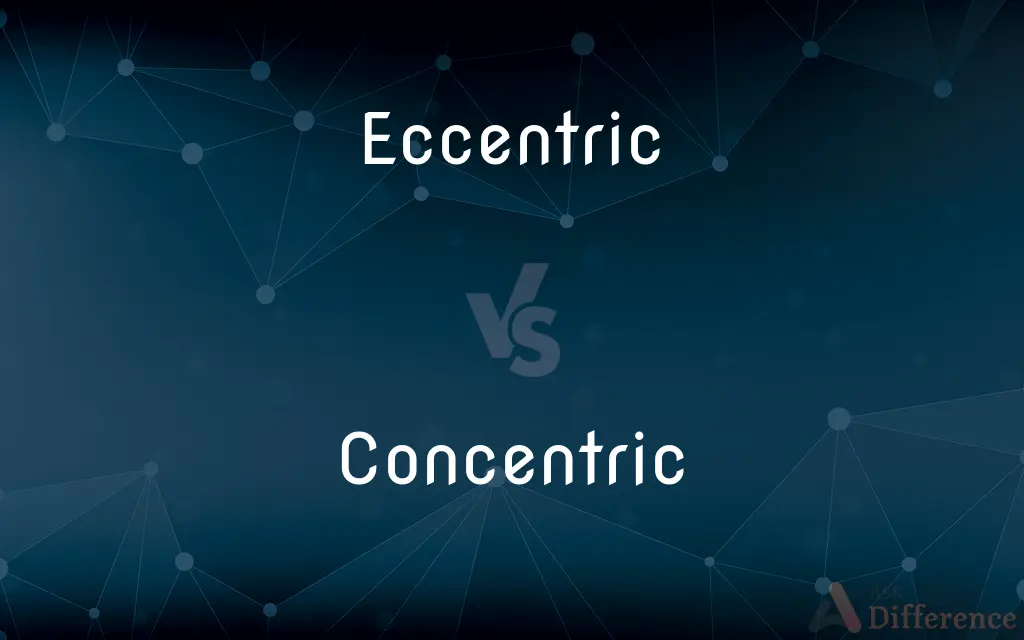Eccentric vs. Concentric — What's the Difference?
By Maham Liaqat & Fiza Rafique — Updated on February 22, 2024
Eccentric contraction involves muscle lengthening under tension, often associated with deceleration, while concentric contraction involves muscle shortening, typically associated with accelerating movement.

Difference Between Eccentric and Concentric
Table of Contents
ADVERTISEMENT
Key Differences
Eccentric and concentric contractions are two types of muscle actions that occur during physical activities, playing crucial roles in movement and strength development.
Eccentric contraction occurs when a muscle lengthens under load or tension, such as when lowering a weight during a bicep curl. This type of contraction is often linked to muscle control and deceleration, helping absorb energy and reduce force on joints and tendons. Conversely, concentric contraction is characterized by the shortening of a muscle as it contracts, like when lifting a weight upwards in a bicep curl. This action is primarily associated with the generation of force and acceleration of body parts.
The interplay between eccentric and concentric contractions within a single exercise or movement sequence ensures a comprehensive muscle workout, enhancing strength, power, and endurance.
Eccentric contractions are particularly noted for their role in muscle strengthening and rehabilitation, given their efficiency and the significant mechanical stress they impose on muscle fibers, which can lead to increased muscle mass and strength. Meanwhile, concentric contractions are essential for the dynamic phase of lifting and moving, playing a pivotal role in overall muscular development and functional performance.
Understanding the differences between eccentric and concentric muscle contractions is essential for designing effective training and rehabilitation programs, as each plays a unique role in muscle physiology, performance enhancement, and injury prevention. By incorporating both types of contractions into a training regimen, individuals can achieve a balanced and comprehensive approach to fitness and health.
ADVERTISEMENT
Comparison Chart
Definition
Muscle lengthens under tension
Muscle shortens as it contracts
Role in Movement
Deceleration and control
Acceleration and force generation
Energy Efficiency
More efficient, less energy for more work
Less efficient, more energy for less work
Impact on Muscle
Greater potential for muscle hypertrophy and strength
Essential for muscle power and movement initiation
Examples
Lowering a weight during a bicep curl
Lifting a weight during a bicep curl
Compare with Definitions
Eccentric
Muscle lengthens under load.
Lowering the barbell slowly in a bench press.
Concentric
Muscle shortens as it contracts.
Pushing off the ground during a jump.
Eccentric
Important for rehabilitation.
Eccentric exercises are used to strengthen injured tendons.
Concentric
Associated with acceleration.
Sprinting starts with concentric contraction of the leg muscles.
Eccentric
Associated with deceleration.
Running downhill involves eccentric contraction of leg muscles.
Concentric
Builds muscle power.
Explosive lifts improve concentric contraction strength.
Eccentric
Induces muscle hypertrophy.
Incorporating slow negatives increases muscle growth.
Concentric
Less efficient in energy use.
Rapid movements tire muscles more quickly.
Eccentric
Efficient in energy use.
Eccentric contractions help absorb impact with less fatigue.
Concentric
Initiates movement.
Standing up from a chair requires concentric leg muscle contraction.
Common Curiosities
Can eccentric contractions cause muscle soreness?
Yes, eccentric contractions can lead to delayed onset muscle soreness (DOMS) due to the increased stress on muscle fibers.
Why are eccentric contractions considered more efficient?
They require less energy to perform a given amount of work compared to concentric contractions, making them more efficient.
How do concentric and eccentric contractions work together?
They often occur sequentially in activities, with eccentric contractions controlling movement and concentric contractions initiating movement, providing a balanced muscle workout.
Why are eccentric exercises important in rehabilitation?
They strengthen muscles and tendons with less joint stress, making them ideal for recovery and injury prevention.
Can focusing on eccentric contractions improve performance?
Yes, focusing on the eccentric phase can enhance muscle strength, control, and endurance, positively impacting performance.
How do muscles act during concentric contractions?
Muscles generate force by shortening, moving two points closer together, like the elbow and shoulder during a bicep curl.
How can I incorporate both types of contractions in my workout?
Include exercises that emphasize both lowering (eccentric) and lifting (concentric) phases, like squats, curls, and presses.
Is one type of contraction better than the other?
Both are essential for balanced muscle development, strength, and functionality; neither is better, but their application depends on the goal.
What is eccentric contraction?
Eccentric contraction is when a muscle lengthens under tension, often used for controlling movements and absorbing energy.
What is concentric contraction?
Concentric contraction is when a muscle shortens as it contracts, typically used for generating force and accelerating movement.
What role do concentric contractions play in sports?
Concentric contractions are crucial for explosive movements, such as jumping or sprinting, essential in many sports.
What's the risk of only focusing on concentric movements?
It can lead to imbalances and neglect the benefits of eccentric training, such as increased muscle control and efficiency.
How do eccentric and concentric contractions affect muscle growth?
Both contribute to muscle growth by creating different types of stress on the muscle, with eccentric contractions often leading to more significant hypertrophy.
Do eccentric contractions use more muscle fibers?
Yes, they engage more muscle fibers, particularly for controlling the lengthening process, leading to greater strength gains.
What's the benefit of concentric exercises?
They build muscle power and are essential for initiating movements, beneficial for overall fitness and specific sports performance.
Share Your Discovery

Previous Comparison
Tactician vs. Strategist
Next Comparison
Invention vs. DiscoveryAuthor Spotlight
Written by
Maham LiaqatCo-written by
Fiza RafiqueFiza Rafique is a skilled content writer at AskDifference.com, where she meticulously refines and enhances written pieces. Drawing from her vast editorial expertise, Fiza ensures clarity, accuracy, and precision in every article. Passionate about language, she continually seeks to elevate the quality of content for readers worldwide.
















































